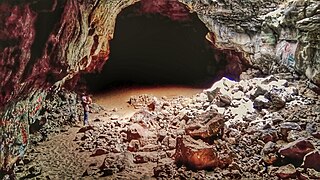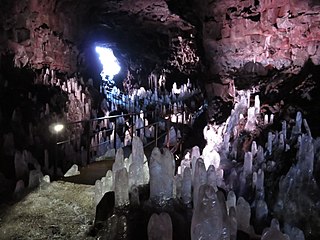
A stalactite (, ; from the Greek 'stalaktos' via stalassein, is a mineral formation that hangs from the ceiling of caves, hot springs, or man-made structures such as bridges and mines. Any material that is soluble and that can be deposited as a colloid, or is in suspension, or is capable of being melted, may form a stalactite. Stalactites may be composed of lava, minerals, mud, peat, pitch, sand, sinter, and amberat. A stalactite is not necessarily a speleothem, though speleothems are the most common form of stalactite because of the abundance of limestone caves.

The Undara Volcanic National Park is a national park in the Shire of Etheridge, Queensland, Australia. It is situated 275 kilometres southwest of Cairns just off the Gulf Developmental Road. The park was established in 2009 to protect Australia longest lava tube and the unique fauna and flora found of the area. The basalts of the area form part of the Cenozoic McBride Basalt (Volcanic) Provence. The volcanics are all less than 8 million year old (Ma) with the youngest only 7,000 years old.

A stalagmite is a type of rock formation that rises from the floor of a cave due to the accumulation of material deposited on the floor from ceiling drippings. Stalagmites are typically composed of calcium carbonate, but may consist of lava, mud, peat, pitch, sand, sinter and amberat.

A lava tube, or pyroduct, is a natural conduit formed by flowing lava from a volcanic vent that moves beneath the hardened surface of a lava flow. If lava in the tube empties, it will leave a cave.
Cupola is a structure located on top of a larger roof or dome.

A pit crater is a depression formed by a sinking or collapse of the surface lying above a void or empty chamber, rather than by the eruption of a volcano or lava vent. Pit craters are found on Mercury, Venus, Earth, Mars, and the Moon. Pit craters are often found in a series of aligned or offset chains and in these cases, the features is called a pit crater chain. Pit crater chains are distinguished from catenae or crater chains by their origin. When adjoining walls between pits in a pit crater chain collapse, they become troughs. In these cases, the craters may merge into a linear alignment and are commonly found along extensional structures such as fractures, fissures and graben. Pit craters usually lack an elevated rim as well as the ejecta deposits and lava flows that are associated with impact craters. Pit craters are characterized by vertical walls that are often full of fissures and vents. They usually have nearly circular openings.

A lava cave is any cave formed in volcanic rock, though it typically means caves formed by volcanic processes, which are more properly termed volcanic caves. Sea caves, and other sorts of erosional and crevice caves, may be formed in volcanic rocks, but through non-volcanic processes and usually long after the volcanic rock was emplaced.

The Lava River Cave near Bend, Oregon, is part of the Newberry National Volcanic Monument, which is managed by the United States Forest Service. At 5,211 feet (1,588 m) in length, the northwest section of the cave is the longest continuous lava tube in Oregon. While the cave's discovery in 1889 was officially credited to a pioneer hunter, the presence of obsidian flakes near the cave has led archaeologists to conclude that Native Americans knew about the cave long before settlers arrived in central Oregon.

Surtshellir is a lava cave located in western Iceland, around 60 km from the settlement of Borgarnes. Approximately a mile in length, it is one of the longest such caves in the country. It was the first known lava tube in the world, at least by modern speleologists, and remained the longest known lava tube until the end of the 19th century. While mentioned in the medieval historical-geographical work Landnámabók, Eggert Ólafsson was the first to give a thorough documentation of the cave in his 1750 travels of the region. It is named after the fire giant Surtr, a prominent figure in Norse mythology, who is prophesied to one day engulf the world in the fire of his flaming sword.

Pluto's Cave is a partially collapsed lava tube on the northern outskirts of Mount Shasta in the Klamath National Forest. Its main entrance is located close to the 99-97 Cutoff c. 12 miles (19 km) North-east of Weed and c. 14 miles (23 km) East-southeast of Grenada. The tube is roughly 190,000 years old, which is quite old for a lava tube, as they normally collapse quickly, having ceilings only a few metres thick. However, Pluto's Cave is located in a semi-arid climate, where erosion is restricted, which contributes to its survival.

Skeleton Cave is a lava tube within Deschutes County, Oregon, of the United States. The cave is within Deschutes National Forest and is located on the northern flank of Newberry Volcano near the city of Bend. The cave is between 75,000 and 400,000 years old.

Gruta das Torres, is a lava cave, a geological formation of volcanic origin formed from the flow and cooling of subterranean magma rivers. This formation is located outside the parish of Criação Velha, in the municipality of Madalena, on the western flanks of the island of Pico. The cave system formed from a series of pāhoehoe lava flows which originating from the Cabeço Bravo parasitic cone about 500 to 1500 years ago. The caves are a group of interconnected lava tubes between 0.5–22 metres (2–72 ft) width, created from both pāhoehoe and ʻaʻā types of lavas generated during different geological periods. It has a height between 1.1 and 15 metres (3.6–49 ft) and is located at an elevation of 300 metres (980 ft). With an estimated length of over 5.2 km (3.2 mi) it is the longest lava cave in the Azores. Access to the cave was managed by the Mountaineering Association. Starting in 2011, AZORINA, SA took over the management and organization of the cave.

Lunar lava tubes are lava tubes on the Moon formed during the eruption of basaltic lava flows. When the surface of a lava flow cools, it hardens and the lava can channel beneath the surface in a tube-shaped passage. Once the flow of lava diminishes, the tube may drain, forming a hollow void. Lunar lava tubes are formed on sloped surfaces that range in angle from 0.4° to 6.5°. These tubes may be as wide as 500 metres (1,600 ft) before they become unstable against gravitational collapse. However, stable tubes may still be disrupted by seismic events or meteoroid bombardment.

A speleogen is a geological feature within a karst system that is created by the dissolution of bedrock. As rain water falls through the atmosphere it picks up carbon dioxide and more as it passes through organic material in the soil. As water moves through joints and cracks in calcium carbonate bedrock, more dissolution of the bedrock occurs and the bedrock features that are left are the speleogens. This process called speleogenesis is what leads to secondary formations or speleothems.

Derrick Cave is a lava tube located in the remote northwest corner of Lake County, Oregon. The cave is approximately 1,200 feet (370 m) long. It is up to 80 feet (24 m) wide and 46 feet (14 m) high in places. It was named in honor of H.E. Derrick, a pioneer rancher with a homestead 3 miles (4.8 km) southeast of the cave. The land around the cave is managed by the United States Department of Interior, Bureau of Land Management. Derrick Cave is open to the public year-round; however, camping is no longer permitted in the cave.

Martian lava tubes are volcanic caverns on Mars that are believed to form as a result of fast-moving, basaltic lava flows associated with shield volcanism. Lava tubes usually form when the external surface of the lava channels cools more quickly and forms a hardened crust over subsurface lava flows. The flow eventually ceases and drains out of the tube, leaving a conduit-shaped void space which is usually several meters below the surface. Lava tubes are typically associated with extremely fluid pahoehoe lava. Gravity on mars is about 38% that of Earth's, allowing Martian lava tubes to be much larger in comparison.
There are a number of terms that are used in connection with caves, caving and speleology. The following is an incomplete list.
Boyd Cave is a lava tube within Deschutes County, Oregon, of the United States. The cave is within Deschutes National Forest and is located on the northern flank of Newberry Volcano near the city of Bend.
Skylight Cave is a lava tube within Deschutes County, Oregon, of the United States. The cave is within Deschutes National Forest and is located east of Belknap Crater about ten miles west of the city of Sisters. Skylight Cave is closed to visitation from October 1 to April 29 because of hibernating Townsend's big-eared bats.

Raufarhólshellir is the fourth-longest lava tube in Iceland. The cave's proximity to Reykjavík made it popular with visitors, who caused damage to the cave. In late 2016 the cave was closed to the public to clear accumulated garbage and install lighting and a walkway to part of the cave. The cave reopened for guided tours the following year.















